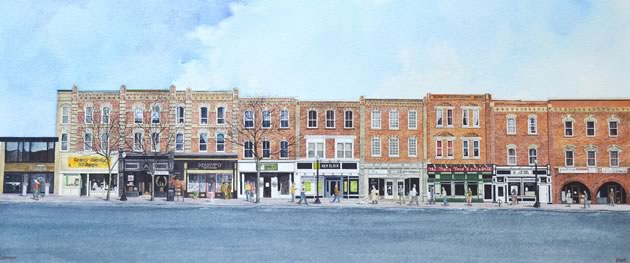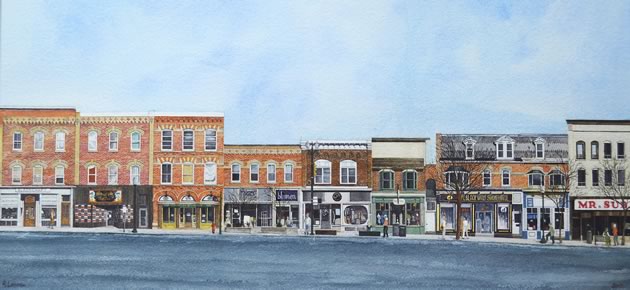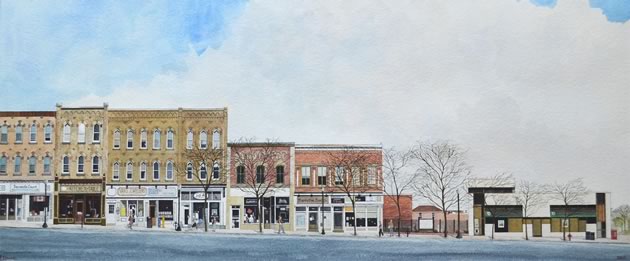Broadway Revival
How downtown Orangeville rediscovered its groove
Like a proud father talking about a well-loved offspring, Orangeville contractor Jim Hope surveys the intricate maroon, charcoal and pale grey storefront at 169 Broadway, now home to a yoga studio.
“I tried to bring its history back,” he says, looking up at the façade he restored last year for owners Ken and Shelley Wishart.
As Hope shares the signature details he has perfected by working on similar renovations on Orangeville’s main thoroughfare, he runs his hands along the intricately layered wooden mouldings and points up at the graceful gooseneck lights that are becoming ubiquitous along the spruced-up street.
Sure, the entrance is not centred as it would have been in the 1870s when the building was probably in its heyday, and there are other anachronisms (including the obvious fact that yoga had not yet taken off as a pastime). But Hope has done his best to respect the paint colours and woodwork of the era.
“A hundred years ago they spent a lot of money on trims,” he says of business owners back in the day.
When possible, they still do. Contractors like Hope, building and business owners, and the town of Orangeville have been actively rejuvenating and repairing Broadway, transforming the old downtown into a destination for work, shopping, theatre, dining and public affairs.
The apartments above the street-level businesses are home to some owners, as well as to those who love high ceilings and bright rooms, and enjoy having a vibrant, walkable street at their doorstep. On Saturdays, the farmers’ market at Second Street next to the town hall adds to the feel-good bustle of a small town that has survived the onslaught of big-box stores, online shopping and other modern diversions.
The many upgraded building façades are the literal face of a business and community spirit that believes in the virtues of small-scale, sustainable living. As Shelley Wishart puts it, “I do think Orangeville is having its moment. It’s only going to get better and better.”

This Broadway streetscape was painted by Orangeville artist Alex Lennox. A few storefronts have been updated for this publication. The original triptych measures 8½ feet long and 16 inches high, and took the artist 450 hours to complete. It is currently exhibited for sale at Dragonfly Arts on Broadway. Click for larger image.
A bit of history
It helps, of course, that many of the buildings on Broadway have great bones to begin with. You would have to go as far as Port Perry or Goderich to see similar streetscapes of impressive three-storey brick buildings. In many small Ontario towns, these venerable old buildings were torn down in the 1960 and ’70s because they had fallen into disrepair and the owners lacked the funds to fix them, says Heritage Orangeville committee member and Broadway expert Diana Tracey.
Broadway’s original buildings were mostly one- or two-storey Georgian structures constructed of wood, but a number of them were destroyed by fires in the mid to late 1800s. Many owners then decided to spiff up their holdings with fashionable Italianate references. Less ornate than the Victorian-Gothic style common for private residences, this look included decorative cornices, two-colour brickwork, and tall pedimented windows with segmental arched tops.
“The up-and-coming merchant class wanted to impress,” says Tracey. “This style was about putting a good face forward.”
Today, much of downtown Broadway lies within a designated heritage conservation district, and building permits for putting a fresh face on individual buildings that have been designated must be approved by Heritage Orangeville, a standing committee that advises council on heritage matters. The committee’s oversight was strengthened in 1998 when the town created a financial incentive for businesses to beautify their façades.
Through the Downtown Heritage Conservation District Façade Assistance Program, the town offered matching grants of up to $10,000 to business owners who wanted to renovate their storefronts – until this year, when the program was suspended. Some observers are concerned this change may not only slow down further street-level transformations, but halt them completely.
The guidelines owners are asked to respect are flexible, but as Tracey explains, the committee encourages building owners to maintain existing Georgian, Victorian and Italianate period details – or replicate what they can if they’ve been lost.
Tracey calls this an “ongoing process of growth.” Generally speaking, for a large swath of Broadway, the committee hopes to preserve or replicate details that were in place when the structures were first built, but there is no fixed template.
“We don’t want it to look like what we’d call Disneyworld, where everything looks exactly the same,” she says. “It would never have looked like that.”
For most of the three-story brick buildings on the north side of Broadway, Tracey and her colleagues ask owners to hew to painted wooden storefronts if possible, in combinations of heritage colours available from many paint manufacturers – browns, yellows, golds, reds, blues, greens, blacks. White? Not so much.
“White paint was the most expensive paint you could get. The titanium white used to make it was extremely expensive,” Tracey explains. “So unless it was a whitewash, they didn’t use a lot of white. We suggest more of an off-white or yellow.”
That was a discussion when the décor boutique Pear Home opened. The owner opted for an off-white rather than a brilliant white façade.
The “better” shops would have had pilasters, columns built into their façades. Then, as now, this addition would have been pricey to create and maintain. Transom windows above the doors would have let in light. And because of the price of importing glass, plate glass windows would not have been used until the late 1800s, and were mimicked instead by many small panes, Tracey says.
With their central doorways and layered woodwork, two of the most historically unchanged storefronts in the district welcome visitors to Glasscraft and Henning Salon, she says. “I just love Henning Salon – the wood, the glasswork. It’s just gorgeous. Very few have kept all those details intact.”

This Broadway streetscape was painted by Orangeville artist Alex Lennox. A few storefronts have been updated for this publication. The original triptych measures 8½ feet long and 16 inches high, and took the artist 450 hours to complete. It is currently exhibited for sale at Dragonfly Arts on Broadway. Click for larger image.
New buildings, such as the Wellington-Dufferin-Guelph Public Health building that opened last year at 180 Broadway, were encouraged to meld contemporary design with the street’s heritage aesthetic by keeping the proportions similar to those of other buildings in the area. The building’s exterior bricks match the bricks of the original building on the site, a limestone facing was added as a reminder of the limestone that might have been locally sourced in the late 1800s, and some of the original bricks were reclaimed and incorporated into the building’s interior.
“It doesn’t look out of place, but you know it’s a modern building,” says Tracey.
On a tour of Broadway, Hope casts his practised eye over storefronts where façade details could use a little heritage-sensitive love. But Tracey says she knows this work is expensive and she’d rather see something than nothing: “Anything to keep the standards on the street as high as possible is what we’re aiming for.”
In addition to the storefronts, the street itself has serious historical cred, thanks to its rare width. Broadway is 100 feet wide, rather than the 60 feet more typical of southern Ontario towns. The land to create the broad avenue was donated by property owners, including town founder Orange Lawrence, in the 1850s. (And, yes, like the numbered streets and avenues north of Broadway, the street name was inspired by Manhattan.)
In recent years, the street itself has been embellished to enhance this distinguishing feature. A controversial and massive landscaped central boulevard was completed in 2006, and then in 2007 the town added a 7.5-foot, 2,700-pound sculpture of Orange Lawrence.
Lawrence settled here in about 1844 and built mills and other buildings, and for a short time operated the tavern in the distinctive stone building at Broadway and Third Street. Built by tavern keeper James Graham in the 1860s and best known in recent years as Greystones Inn, the Georgian-style building is newly home to SteakHouse63, named for its street number.
The Sproule’s effect
Much of the rejuvenation of the downtown started with a single storefront: the Sproule’s Drug Store building at 153 Broadway, which was rescued from under a metal façade in the early 1990s by pharmacist Don Sproule.
Above the door, a locally made stained glass window incorporates the date 1876, the year the building was constructed. And when the Sproules took down the backlit sign, they discovered magnificent red brick arches above the doors and windows, which they were able to restore.
Jill Sproule says her late father’s work provided impetus to other owners on Broadway. “It’s fantastic. You hear people who are visiting Orangeville – they appreciate that the town looks as good as it does,” she says. With her sister Patricia, she now runs Sproule’s Emporium, which sells fair-trade goods in the family-owned building that once housed her dad’s drug store.
Building on what might be called “the Sproule’s effect,” the façade grant has been responsible for much of Broadway’s new swagger.
A façade makeover can easily cost about $30,000, says Hope, and according to Orangeville communications manager Sheila Duncan, the town has approved 66 grants totalling $457,000 since 1999. An additional $1.6 million in private investment has gone into the façade renovations.
In the town’s 2015 budget, however, the $30,000 earmarked for the program was eliminated, as mayor Jeremy Williams strove to keep the property tax increase to zero.
“Hopefully during next year’s budget deliberations, council will reinstate the program,” says deputy mayor Warren Maycock, a past, long-term chair of the grant program.
During the budget discussions, Heritage Orangeville chair Sylvia Bradley reported to council that the grant had helped Orangeville’s downtown become the “envy of many small communities across Ontario,” in part because of the low vacancy rates in the downtown core.
Business owners and heritage lovers alike are saddened to hear the grant may be history. Regardless of the dollar figures, says Shelley Wishart, the grant’s availability inspires building owners to dream of restoration.
“More important, it shows the town’s commitment to the downtown core, and all the possibilities a beautiful downtown Orangeville offers for the population and the surrounding area,” she says.
While architectural scholarship and nerd-dom is a rewarding pursuit for those involved, Tracey says the goal of the committee also has a broader practical purpose: attracting residents and tourists to keep downtown businesses viable and boost community spirit.
“If a town looks good and looks prosperous, it will be prosperous. When it starts to get empty storefronts that don’t look kept, people start to stay away. And it compounds itself,” she says.

This Broadway streetscape was painted by Orangeville artist Alex Lennox. A few storefronts have been updated for this publication. The original triptych measures 8½ feet long and 16 inches high, and took the artist 450 hours to complete. It is currently exhibited for sale at Dragonfly Arts on Broadway. Click for larger image.
Back at Discover Your Yoga at 169 Broadway, Hope leads a gleeful tour of the indoor renovation that followed his exterior work. The former music store, Aardvark, was stripped down to the brick to create the Victorian-interior-meets-Zen-garden yoga studio, run by tenant and upbeat yogi Lindsay Vandenhurk.
Even if you are not a devotee of downward dogs and sun salutations, it may be worth taking a class or booking a spa treatment here in order to check out the space’s reclaimed church windows refurbished as interior doors, soaring ceilings, some with the original pressed tin, and uncovered brick walls, all lovingly updated by Hope and his team.
As the most recent evidence of Broadway’s successful rejuvenation, this temple-like space feels like a fitting location to ponder the evolutions of history.
All along Broadway
The Broadway streetscape on this page was painted by Orangeville artist Alex Lennox. A few storefronts have been updated for this publication. The original triptych measures 8½ feet long and 16 inches high, and took the artist 450 hours to complete. It is currently exhibited for sale at Dragonfly Arts on Broadway.
Tour Orangeville’s historic downtown for yourself
Heritage Orangeville has created a colourful, informative brochure for a self-guided walking tour that enables visitors and residents alike to see for themselves the buildings mentioned in this article, as well as many others. Available at the town hall, which is a centrepiece of the Broadway rejuvenation, the brochure can also be downloaded from the town’s website: orangevilletourism.ca.







It is a little disturbing that after having written such a beautiful piece about my store Aardvark Music & Culture that you refer to it in the above article as if it doesn’t exist any more. It was not my choice to move my business, but it remains a vital part of our community.
Aardvark Music & Culture is now located in the Leaders building at 229 Broadway Unit 11 at John St. and Broadway.
http://www.ardvarkmusic.ca
519-941-4100
In the words of Forrest Gump…”Beauty is as beauty does”
Perry Joseph from 229 Broadway Unit 11 on Oct 4, 2015 at 10:47 am |
With apologies. We didn’t mean to imply that Aardvark is gone. It’s a wonderful place and I appreciate your reminding us that you are still very much part of Broadway and the local music community. For those who want to know more, see the feature story on Aardvark at:
https://www.inthehills.ca/2013/06/back/double-bass-dreams/
In The Hills Magazine from Mono on Oct 6, 2015 at 12:18 pm |
Thank you very much!
Perry Joseph on Oct 6, 2015 at 4:56 pm